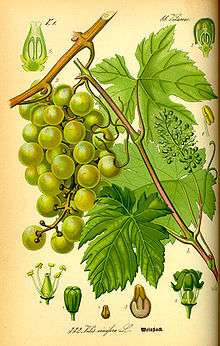Grape seed oil
 Grape seed oil in clear glass vial | |
| Fat composition | |
|---|---|
| Saturated fats | |
| Total saturated |
Palmitic: 7% Stearic: 4% |
| Unsaturated fats | |
| Total unsaturated | 86% |
| Monounsaturated | 16.1% |
| Palmitoleic acid | <1% |
| Oleic acid | 15.8% |
| Polyunsaturated | 69.9% |
| Omega-3 fatty acids | α-Linolenic: 0.1% |
| Omega-6 fatty acids | Linoleic: 69.6% |
| Properties | |
| Food energy per 100 g (3.5 oz) | 3,700 kJ (880 kcal) |
| Smoke point | 216 °C (421 °F) |
| Iodine value | 124-143 |
| Saponification value |
126 (NaOH) 180-196 (KOH) |
| Unsaponifiable | 0.3% - 1.6% |
| Peroxide value | 2.92 mequiv/kg |
Grape seed oil (also called grapeseed oil or grape oil) is pressed from the seeds of grapes, and is thus an abundant by-product of winemaking.[1]
Uses
Cooking
Grape seed oil has a moderately high smoke point of approximately 216 °C (421 °F). Due to its clean, light taste, and high polyunsaturated fat content, it may be used as an ingredient in salad dressings and mayonnaise and as a base for oil infusions of garlic, rosemary, or other herbs or spices. It is widely used in baked goods, pancakes, and waffles. It is sprayed on raisins to help them retain their flavor.[2]
Research
A study of 21 grape cultivars showed variation of oil composition, especially for linoleic acid and tocopherols.[3]
Although grape seeds contain polyphenols, such as proanthocyanidins,[4] grape seed oil contains negligible amounts of these compounds.[5] Grape seed oil components are under study for their potential applications in human health, but the scientific quality of clinical research as of 2016 has been inadequate to suggest any effect on lowering disease risk.[6]
Potential medicinal complications
Grapeseed oil has occasionally been found to contain dangerous levels of polycyclic aromatic hydrocarbons because of direct contact with combustion gases during the drying process.[7]
Composition

The following table lists a typical fatty acid composition of grape seed oil:[8]
| Acid | Type | Percentage |
|---|---|---|
| Linoleic acid | ω−6 unsaturated | 69.6% |
| Oleic acid | ω−9 unsaturated | 15.8% |
| Palmitic acid (Hexadecanoic acid) |
Saturated | 7% |
| Stearic acid (Octadecanoic acid) |
Saturated | 4% |
| Alpha-linolenic acid | ω−3 unsaturated | 0.1% |
| Palmitoleic acid (9-Hexadecenoic acid) |
ω−7 unsaturated | less than 1% |
Grape seed oil also contains 0.8 to 1.5% unsaponifiables rich in phenols (tocopherols) and steroids (campesterol, beta-sitosterol, stigmasterol).[9] Grapeseed oil contains small amounts of vitamin E, but safflower oil, cottonseed oil, or rice bran oil contain greater amounts.[10] Grapeseed oil is high in polyunsaturates and low in saturated fat.
See also
References
- ↑ Aizpurua-Olaizola, Oier; Ormazabal, Markel; Vallejo, Asier; Olivares, Maitane; Navarro, Patricia; Etxebarria, Nestor; Usobiaga, Aresatz (2015-01-01). "Optimization of Supercritical Fluid Consecutive Extractions of Fatty Acids and Polyphenols from Vitis Vinifera Grape Wastes". Journal of Food Science. 80 (1): E101–E107. doi:10.1111/1750-3841.12715. PMID 25471637.
- ↑ Bewley, J. Derek; Black, Michael; Halmer, Peter (2006). The encyclopedia of seeds: science, technology and uses. CABI. ISBN 0-85199-723-6.
- ↑ Sabir, A; Unver, A; Kara, Z (2012). "The fatty acid and tocopherol constituents of the seed oil extracted from 21 grape varieties (Vitis spp.)". Journal of the Science of Food and Agriculture. 92 (9): 1982–7. doi:10.1002/jsfa.5571. PMID 22271548.
- ↑ Joshi, SS; Kuszynski C. A.; Bagchi D. (2001). "The cellular and molecular basis of health benefits of grape seed proanthocyanidin extract". Curr Pharm Biotechnol. 2 (2): 187–200. doi:10.2174/1389201013378725. PMID 11480422.
- ↑ Nakamura, Y; Tsuji S; Tonogai Y (2003). "Analysis of proanthocyanidins in grape seed extracts, health foods and grape seed oils" (PDF). Journal of Health Science. 49 (1): 45–54. doi:10.1248/jhs.49.45.
- ↑ Garavaglia, J; Markoski, M. M.; Oliveira, A; Marcadenti, A (2016). "Grape Seed Oil Compounds: Biological and Chemical Actions for Health". Nutrition and Metabolic Insights. 9: 59–64. doi:10.4137/NMI.S32910. PMC 4988453. PMID 27559299.
- ↑ Moret, S.; Dudine, A.; Conte, L.S. (2000). "Processing effects on the polyaromatic hydrocarbon content of grapeseed oil" (PDF). Journal of the American Oil Chemists' Society. 77 (12): 1289–1292. doi:10.1007/s11746-000-0203-5. Retrieved 16 November 2012.
- ↑ Kamel, B. S.; Dawson H.; Kakuda Y. (1985). "Characteristics and composition of melon and grape seed oils and cakes". Journal of the American Oil Chemists' Society. 62 (5): 881–883. doi:10.1007/BF02541750.
- ↑ Oomah, BD; Liang J; Godfrey D; Mazza G (1998). "Microwave Heating of Grapeseed: Effect on Oil Quality" (PDF). J. Agric. Food Chem. 46 (10): 4017–4021. doi:10.1021/jf980412f.
- ↑ Herting, D. C.; Drury, E. J. E. (1963). "Vitamin E Content of Vegetable Oils and Fats". J. Nutr. 81: 4017–4021. PMID 14100992.